Surviving a Plane Crash Pt2 – Planning
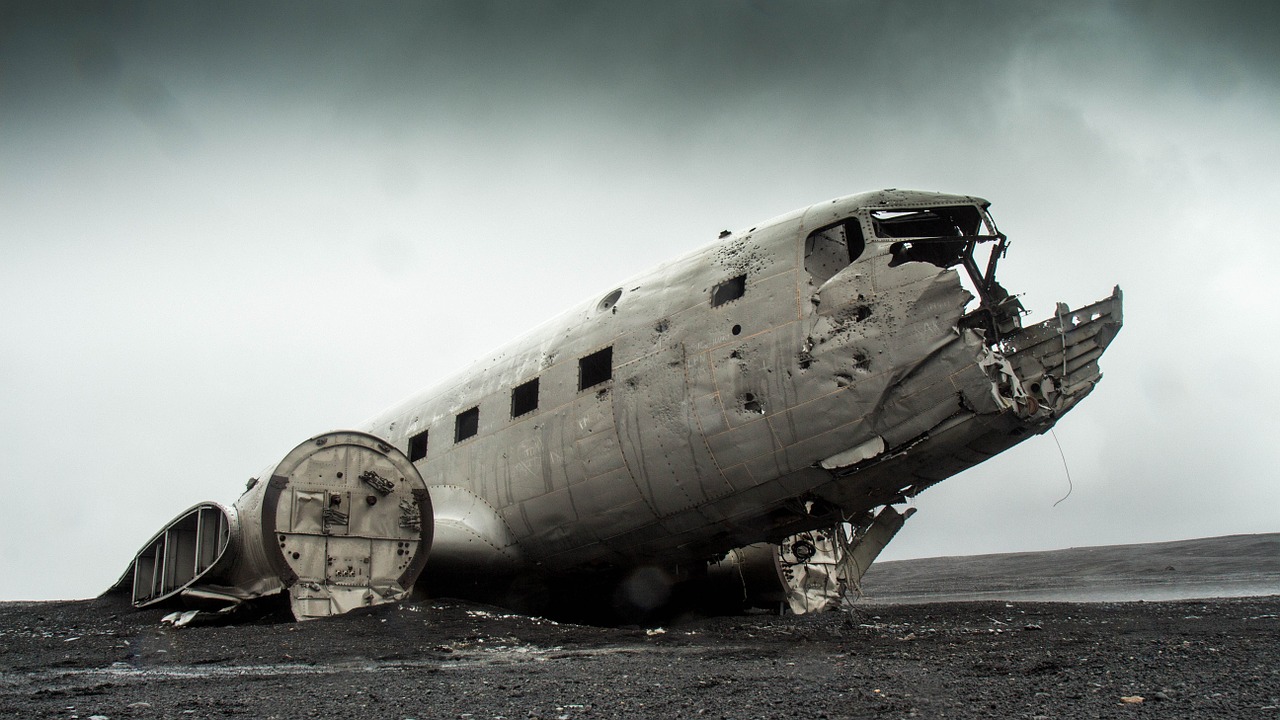
Plan:
This article is all about thinking about survival and planning what you would do to survive in different scenarios; also preparing yourself as well as one can. The key to giving yourself the best chance of surviving an air crash is planning – as in all survival situations.
The key to giving yourself the best chance of surviving an air crash is planning – as in all survival situations.
Having a notion of what you would do in the event of a crash or forced landing is fundamental to survival. First, listen to the safety announcement and read the safety card; even if you are a frequent flier, safety advice can vary considerably between different types of aircraft.
Know exactly where to find the nearest exits. Actually count the number of rows from your seat to exits in front and behind you; the chances are you might be trying to find your way to an exit in pitch dark and/or thick smoke. Know how to open exit doors as illustrated below.

put on a lifejacket in an airplaneCheck the life vest is actually under your seat. It sounds silly to some, but once I checked and there was nothing there! I said nothing, but at the back of my mind for the whole six–hour flight was the knowledge that if the worst happened, I had no life vest! I determined never to be so blasé about my own personal safety again.
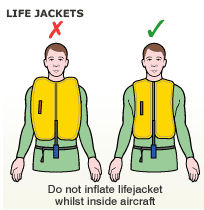
When a commercial plane at altitude gets into trouble it could take several minutes from the warning to impact; so use the time to go through any plan again. Make sure everything you have read above is in place; especially ensure that there is no cargo that can smack into you and that you have nothing in your pockets that could injure you.
The safest seats debate:
Boeing’s website says that, ‘One seat is as safe as another,’ as do the United States’ Federal Aviation Administration, and most UK and European carriers. The old joke that: “Rear seats are safer because no plane is going to reverse into a mountain,” has been shown not to be the case when the rear of some planes fared worse on impact than the nose section.
There really does not seem to be any hard evidence to support the rear seat theory. Having said that, in 2007, Popular Mechanics magazine in the US looked at all crashes since 1971 for which seat survival data was available and claimed that those in rear seats (behind the wing’s trailing edge) were safer — survival rates were 69 per cent as opposed to 56 per cent over the wing and 49 per cent for those at the front of the plane.
Other authorities have decried their findings as flawed.
Crashes vary, and sometimes the only people to survive are those at the front; in other crashes survivors are over the wing. Over the wing seats are possibly best, because the plane is stronger at that point. Also, if the landing is in water, it has been proved that exiting onto a wing means one has more time to prepare before the inevitable soaking.
On the other hand, if the engines are on fire, as happens, being near to the wing is the last place to be! Front, middle or back, it is better to sit in the aisle than in a middle or window seat so you can escape faster.
Spanair Flight JK 5022, from Barajas Airport in Madrid to Gran Canaria Airport in Gran Canaria, Spain, crashed just after take off from runway 36L of Barajas Airport on 20 August 2008.
Of the 172 people on board, 146, including all crew members, perished in the crash or immediately after in the fire; of the 26 passengers rescued alive from the crash site, six died before arriving at the hospital, and two more in hospital, bringing the total number of fatalities to 154.
The diagram below illustrates where the survivors were sitting; again, this belies the school of thought that rear seats are safer in a crash. You just cannot know. One of the stewardesses decided to change seats from the rear to the front of the plane and she was one of the survivors.
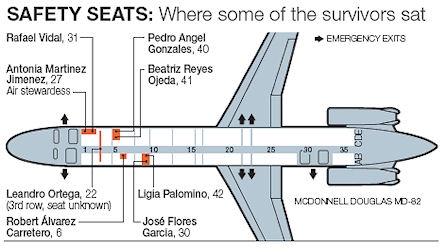
Consider your clothing:
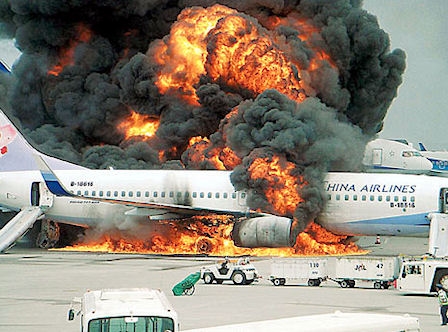
Consider choosing special clothing for your flight, even on a short–haul flight, this gives you the best chance of survival should the plane catch fire or if you end up in the sea. Acrylic, polyester and nylon materials are a no–go.
Experience from all fires teaches us that these synthetics melt at low temperatures and stick to the skin. Nylon melts at 265°C (510°F) and burns at 485°C (905°F). Polyester melts at 254°C (490°F) and burns at 488°C (910°F).
Many synthetics with acrylic melt and burn at lower temperatures. In an aircraft fire, even if you are outside the wreck and escaping the plane, these temperatures are easily achieved. If you are wearing these materials you risk them melting into your skin or catching fire with devastating results.
Wool, and secondly cotton, gives the best protection from fire, but wool especially is less attractive if you end up in the sea; it increases significantly in weight. Choose flame–resistant clothing (Wrangler use flame resistant material for their jeans and jackets, for example.)
Wear lace up shoes, not high heels. Keep your shoes on during the flight. Good footwear can be a decided advantage in an escape.
Consider your exposed areas:
If there is a risk of fire onboard (always a risk in an air crash), make sure you have a wet cloth to cover your head, also your nose and face to protect from smoke if you do not have a smoke hood. Women should cover their hair with wet material, especially if they have long hair and use hair lacquer.
For this reason, it is prudent to carry an extra bottle of water onboard with you and keep it for such an emergency. Pack a piece of cloth in the top of your hand luggage, a Shemagh or tea towel, for example. This is called survival planning!
Wear long pants, sleeves and closed shoes. This will help protect you from glass, metal and the elements.
Traveling with children
If you’re with your family, talk to your children about what to do in the event of an emergency. Divide the responsibility of helping your children between you and your partner. It’s easier for one adult to help a single child than for both to try to keep everyone together.
Cabin depressurizes or there is smoke

If the oxygen masks drop, put one on before attempting to help someone else. If you fall unconscious, you have no chance of helping anyone else.
All planes are different – pay attention to the pre–flight instructions and study the safety card provided.
Has this put you off flying? Let’s put the whole thing in perspective
The International Air Transport Association (IATA) released passenger and freight traffic forecasts projecting that in 2011, the air transport industry would handle 2.75 billion passengers.
Forty–four air crashes in 2011 were recorded in the Plane Crash Database. There were 75% fatalities, 769 out of the 1,028 passengers and crew involved were killed. That’s 769 fatalities out of 2.75 billion passengers; you have a greater chance of winning the national lottery than being killed in an air crash.
The advances in science and technology now mean over 90% of plane crashes have survivors.
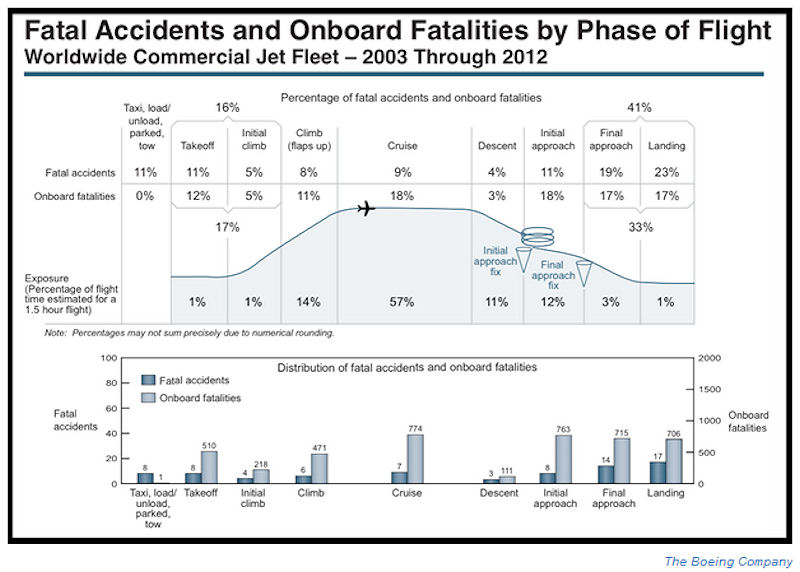

He has many years experience in difficult terrain, notably the Amazon, the African bush and climbing in various mountain regions including the Drakensburg Mountains and the Andes.
If you have any comments then please drop us a message on our Outdoor Revival facebook page
If you have a good story to tell or blog let us know about it on our FB page, we’re also happy for article or review submissions, we’d love to hear from you.
We live in a beautiful world, get out there and enjoy it.
Outdoor Revival – Reconnecting us all with the Outdoors
